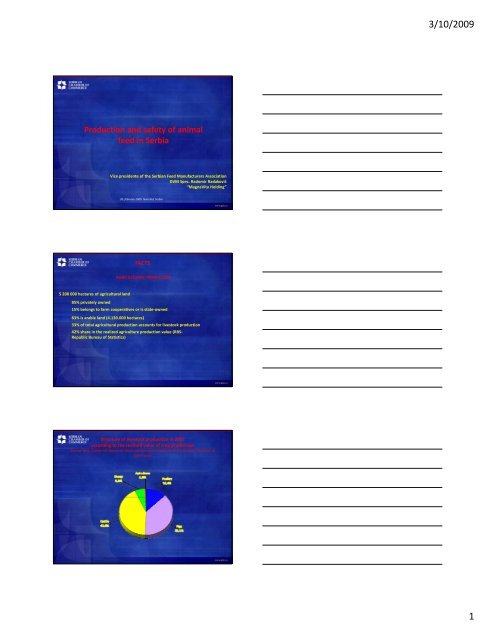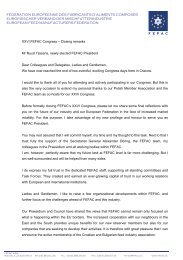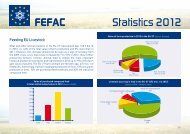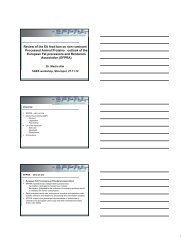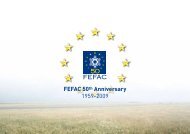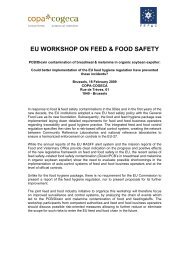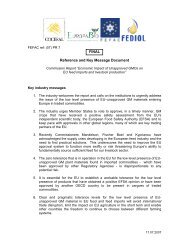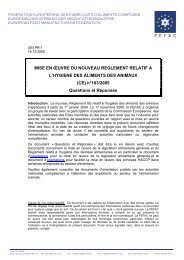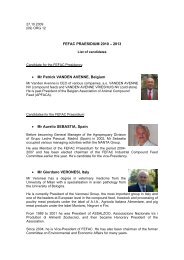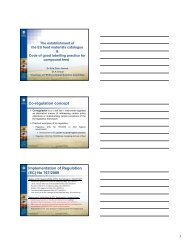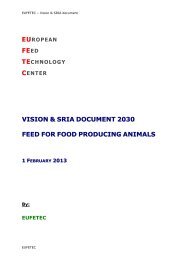Production and safety of animal feed in Serbia - Fefac
Production and safety of animal feed in Serbia - Fefac
Production and safety of animal feed in Serbia - Fefac
Create successful ePaper yourself
Turn your PDF publications into a flip-book with our unique Google optimized e-Paper software.
<strong>Production</strong> <strong>and</strong> <strong>safety</strong> <strong>of</strong> <strong>animal</strong><br />
<strong>feed</strong> <strong>in</strong> <strong>Serbia</strong><br />
Vice presidente <strong>of</strong> the <strong>Serbia</strong>n Feed Manufacturers Association<br />
DVM Spec. Radomir Radaković<br />
“MagnaVita Hold<strong>in</strong>g”<br />
20. february 2009. Novi Sad, <strong>Serbia</strong><br />
FACTS<br />
AGRICULTURAL PRODUCTION<br />
5 200 000 hectares <strong>of</strong> agricultural l<strong>and</strong><br />
85% privately owned<br />
15% belongs to farm cooperatives or is state‐owned<br />
83% is arable l<strong>and</strong> (4.130.000 ( hectares) )<br />
33% <strong>of</strong> total agricultural production accounts for livestock production<br />
42% share <strong>in</strong> the realized agriculture production value (RBS‐<br />
Republic Bureau <strong>of</strong> Statistics)<br />
Structure <strong>of</strong> livestock production <strong>in</strong> 2007<br />
accord<strong>in</strong>g to the realised value <strong>of</strong> crop production<br />
Source: RBS, Center for Research Work <strong>and</strong> Economic Analyses <strong>of</strong> the <strong>Serbia</strong>n Chamber <strong>of</strong><br />
Commerce<br />
3/10/2009<br />
1
ANIMAL FEED INDUSTRY<br />
‐369 registered enterprises (November 2008)<br />
‐ 20 registered exporters to EU countries<br />
‐ 19 registered exporters to non‐EU countries<br />
‐Annual production approx. 824.000 tons (<strong>in</strong>clud<strong>in</strong>g statistics for 2008)<br />
•Compound C df<strong>feed</strong> d 759 759,116 116 ttons<br />
•Supplemental <strong>feed</strong> 49,659 tons<br />
•Premixes 14,387 tons<br />
‐Annual <strong>animal</strong> consumption 2.500.000 tons (estimation)<br />
1.700.000 tons not statistically processed!!!<br />
WHY?<br />
‐non‐regulated market<br />
‐ grey zone (great number <strong>of</strong> “illegal” manufactur<strong>in</strong>g establishments, household<br />
production...)<br />
‐ absence <strong>of</strong> legal norms<br />
‐ absence <strong>of</strong> new <strong>animal</strong> <strong>feed</strong> law<br />
F<strong>in</strong>al results <strong>in</strong> the livestock production depend primarily on the use <strong>of</strong> healthy<br />
<strong>and</strong> quality <strong>feed</strong>!!!<br />
ANIMAL FEED SAFETY<br />
‐HACCP system <strong>and</strong> ISO st<strong>and</strong>ards implemented or <strong>in</strong> the process <strong>of</strong> implementation <strong>in</strong> all <strong>feed</strong><br />
establishments cont<strong>in</strong>u<strong>in</strong>g to operate after 1st September 2009<br />
‐ Monitor<strong>in</strong>g by accredited <strong>and</strong> own <strong>in</strong>‐house laboratories<br />
‐ Local raw material, GMO free<br />
‐ Permitted <strong>feed</strong> additives<br />
‐ Permitted coccidiostats<br />
3/10/2009<br />
2
CHALLENGES<br />
•Agreement on Stabilization <strong>and</strong> Accession to the EU, unilateral application from 1 st<br />
January 2009.<br />
•CEFTA as <strong>of</strong> 2006<br />
•Accession to WTO<br />
•Increased pressure on export<br />
•Follow<strong>in</strong>g the Agreement on Stabilization <strong>and</strong> Accession <strong>in</strong> Montenegro <strong>and</strong> Bosnia<br />
<strong>and</strong> Herzegov<strong>in</strong>a, Herzegov<strong>in</strong>a <strong>Serbia</strong>n <strong>feed</strong> products will have to compete with the products from<br />
EU states imported at lower import duties<br />
•Domestic exporters must be prepared for tough competition not only <strong>in</strong> the <strong>Serbia</strong>n<br />
market, but <strong>in</strong> the market <strong>of</strong> CEFTA countries<br />
BARRIERS TO ANIMAL FEED EXPORT<br />
• Higher prote<strong>in</strong> <strong>feed</strong> prices<br />
• Higher vitam<strong>in</strong> <strong>feed</strong> prices<br />
• Higher micro‐m<strong>in</strong>eral <strong>feed</strong> prices<br />
•Unnecessary bureaucracy (national)<br />
EXPORT- IMPORT OF ANIMAL FEED IN SERBIA<br />
IN THE PERIOD 2003-2007<br />
3/10/2009<br />
3
EXPECTATIONS OF DOMESTIC FEED OPERATORS....<br />
• Animal Feed Law,<br />
to regulate <strong>feed</strong> production issues under market economy conditions.<br />
• Promote quality <strong>of</strong> domestic <strong>animal</strong> <strong>feed</strong><br />
as it has a direct effect on the quality <strong>of</strong> <strong>animal</strong> food products,<br />
• Quality <strong>of</strong> <strong>feed</strong> components,<br />
orig<strong>in</strong>at<strong>in</strong>g from domestic <strong>and</strong> controlled l<strong>and</strong><br />
• IImplementation l t ti <strong>of</strong> f st<strong>and</strong>ards t d d <strong>and</strong> d hharmonisation i ti <strong>of</strong> f f<strong>feed</strong> dadditives dditi regulations lti<br />
with EU legislation<br />
• Official control‐monitor<strong>in</strong>g <strong>of</strong> all <strong>feed</strong> operators<br />
• Monitor technological <strong>in</strong>novations <strong>in</strong> the field <strong>of</strong> <strong>animal</strong> <strong>feed</strong><br />
WHY?<br />
‐Quality <strong>of</strong> <strong>animal</strong> products for human consumption<br />
‐ harmful substances residues (antibiotics, hormones, tox<strong>in</strong>s)<br />
‐ prevention <strong>of</strong> non‐loyal competition<br />
‐ <strong>in</strong>sistence on domestic <strong>animal</strong> <strong>feed</strong> products<br />
‐ reduction <strong>of</strong> “grey zone”, i.e. illegal <strong>feed</strong> operators<br />
•By sign<strong>in</strong>g SAA <strong>Serbia</strong> has undertaken the obligation to harmonise national legislation<br />
with EU regulations<br />
•Legislation Plan <strong>of</strong> the <strong>Serbia</strong>n Government for 2008 <strong>and</strong> 2009 provides for the<br />
adoption <strong>of</strong> Animal Feed Law.<br />
•Proposed law is aimed at enabl<strong>in</strong>g <strong>feed</strong> operators to establish necessary conditions for<br />
susta<strong>in</strong>ed growth, development, competitiveness <strong>and</strong> ultimately survival.<br />
•Ensur<strong>in</strong>g safe <strong>feed</strong> is paramount for the protection <strong>of</strong> human <strong>and</strong> <strong>animal</strong> health, for<br />
meet<strong>in</strong>g consumer expectations regard<strong>in</strong>g quality <strong>and</strong> <strong>safety</strong> <strong>of</strong> foods <strong>of</strong> <strong>animal</strong> orig<strong>in</strong>.<br />
1. What are livestock export figures to the EU?<br />
In 2004 we were advised<br />
“concern<strong>in</strong>g harmonisation <strong>of</strong> national legislation with EU regulations–<br />
without Animal Feed Law <strong>in</strong> place there is hardly any export <strong>of</strong> livestock <strong>and</strong><br />
livestock products to the EU"<br />
2. What are livestock export figures from 2004 to date (without this law)?<br />
3/10/2009<br />
4
Theory is when everyone knows<br />
what they are do<strong>in</strong>g <strong>and</strong> noth<strong>in</strong>g<br />
works.<br />
Practice is when everyth<strong>in</strong>g works<br />
y g<br />
<strong>and</strong> nobody knows why.<br />
3/10/2009<br />
5


